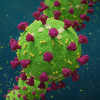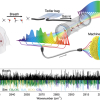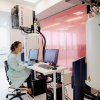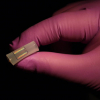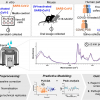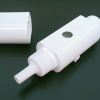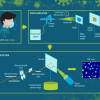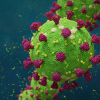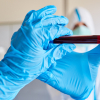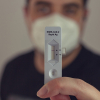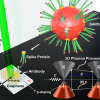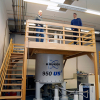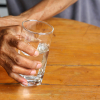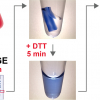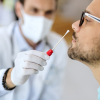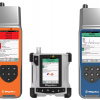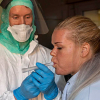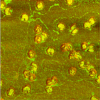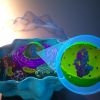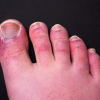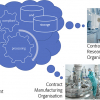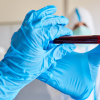Focus on COVID-19
A new platform combines 17-plex assays with MALDI-TOF MS to target 14 different mutation sites of the spike gene.
A breathalyser for detecting COVID and other diseases has been developed by scientists at JILA.
An NMR-based Molecular Phenomics Clinical Research Tool for “Long COVID” multi-organ risk assessment uses a multiplexed combination of biomarkers.
Researchers say the surface enhanced Raman spectroscopy sensor combines accuracy levels approaching that of PCR testing with the speed of rapid antigen tests, and could be used for mass testing at airports, schools and hospitals.
A proof-of-concept FT-IR-based saliva COVID-19 testing workflow has investigated the pathophysiological response to a COVID-19 infection through ATR-FT-IR spectroscopy.
A portable, SERS-based breathalyser can distinguish volatile organic compounds in the breath of COVID-positive people in less than 5 min.
In a study that used inorganic, physical and analytical chemistry to mimic respiratory droplets that can carry viruses, researchers demonstrated a mechanism that enables multiple mask materials to be protective.
Charge detection mass spectrometry enhances traditional mass spectrometry in detecting larger molecules such as coronaviruses.
Researchers have developed a rapid method, based on IR spectra of blood plasma, for differentiating COVID-19-positive patients expected to show severe symptoms from those likely to experience only mild symptoms.
A blood test has been developed, based on ATR-FT-IR spectroscopy, to predict which people infected with COVID-19 are most likely to experience serious symptoms, which could help health care workers prioritise patients for hospitalisation and intensive care.
Work at the Diamond synchrotron has found a way to help reduce false-negative results in lateral flow tests by a simple modification.
Researchers at the University of Illinois Chicago have used graphene and Raman spectroscopy to detect the SARS-CoV-2 virus in laboratory experiments.
For the development of drugs or vaccines against COVID-19, research needs virus proteins of high purity and the ability to determine their three-dimensional protein structures.
A new concept, based on ICP-MS, for rapidly analysing for the presence of a virus from colds to coronaviruses has been proposed.
Researchers at the University of Surrey have found that LC-MS and PLS of non-invasive skin swab samples may be enough to detect COVID-19.
Mass spectrometry can be used to identify Parkinson’s based on compounds found on the surface of skin. The findings offer hope that a pioneering new test could be developed to diagnose the degenerative condition through a simple skin swab.
A novel gel electrophoresis technique has reduced the time for the sample pretreatment of trace marker proteins derived from clinical samples from around 20 to 5 hours.
What can quality sustems tell us about PCR testing for COVID-19? Peter Jenks has some concerns.
Rigaku Analytical Devices has published a new application report describing the use of handheld 1064 nm Raman analysers for a variety of applications involved in the manufacture and testing of hand sanitiser.
Strong investment in photonics will help us fight infectious diseases that kill an unimaginable number of people and prepare us against future pandemics, says Dr Jürgen Popp of the Leibniz Center for Photonics in Infection Research (LPI) that is currently under construction in Jena.
Researchers at the Fraunhofer Project Hub for Microelectronic and Optical Systems for Biomedicine MEOS are now developing solutions designed to enable the analysis of breath gas for the diagnosis of disease including posisbly COVID-19.
Initial findings from a new study using gas chromatography-ion mobility spectrometry has shown how Covid-19 can be detected via a non-invasive breath test, providing almost instant results.
Researchers combined AFM-IR and TERS to study the surfaces and interiors of viruses.
Protein–protein interactions can be probed with a combined approach of affinity purification-mass spectrometry and proximity-dependent biotin identification.
Bruker is supporting the international Covid19-NMR Consortium for structure–function and inhibitor binding investigations of SARS-CoV-2 RNA and proteins.
A research programme is investigating the prognostic value of skin findings associated with COVID-19 infection using a portable hyperspectral imaging system.
Tony Davies and Mohan Cashyap discuss this topic with help from a number of industry experts. Whilst there are undoubted computing and networking issues for regulated industries in allowing working from home as if the user was in the lab, they are not insurmountable.
Bruker is partnering with the Australian National Phenome Centre which has launched a major research and diagnostics project to better understand COVID-19.
The COVID-19 MS Coalition of more than 500 scientists from around the world has been created to share data on COVID-19 gleaned from the use of mass spectrometry techniques to examine people’s blood and other biomarkers.
The multiplexed enhanced protein dynamics (mePROD) mass spectrometry method helps show how a SARS-CoV-2 infection changes the human host cells.
With a significant proportion of our regular readership probably under home lock-down, we were wondering if we could help you at this difficult time by pointing out some useful online resources. So, when we finally come out of this pandemic, you could do so better skilled and more up-to-date than when we went in to it.
The most important parameter to consider in compounding hand sanitiser is the alcohol content. It has also been determined that hand sanitiser with alcohol concentration below 60% (v/v) is not effective and could leave the user at higher risk of infection. This application note describes the use of FT-IR spectroscopy to determine ethanol and isopropanol in hand sanitiser.

